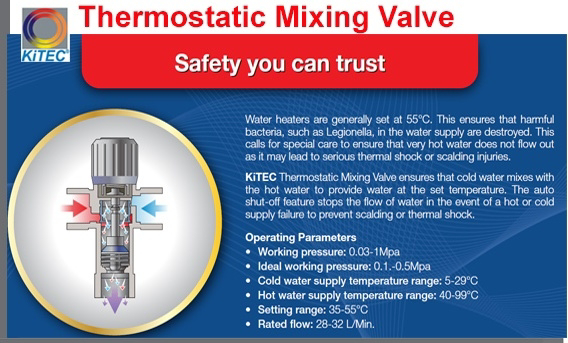KiTEC Hot & Cold Mixture Valve
Let us know what is Scalding effect? and how to avoid it?
Scalding is a form of thermal burn resulting from heated fluids / water such as hot water or steam. Most scalds are considered first or second degree burns, but third degree burns can result, especially with prolonged contact.
Most scalds result from exposure to high-temperature water, such as tap water in baths and showers or cooking water, or from spilled hot drinks, such as coffee.
The temperature of tap water should not exceed 38–45 °C to prevent discomfort and scalding.[2] However, it is necessary to keep warm water at a temperature of 55–60 °C to inhibit the growth of legionella bacteria. Water at 60 °C can induce scalding injuries in less than 3 seconds, while it takes 10 seconds to get an injury at 57 °C and 1.5 to 2 minutes in 52 °C hot water.
A thermostatic mixing valve (TMV) is a valve that blends hot water with cold water to ensure constant, safe shower and bath outlet temperatures, preventing scalding.
The storage of water at high temperature removes one possible breeding ground for Legionella; the use of a thermostat, rather than a static mixing valve, provides increased safety against scalding, and increased user comfort, because the hot-water temperature remains constant.[1]
Many TMVs use a wax thermostat for regulation. They also shut off rapidly in the event of a hot or cold supply failure to prevent scalding or thermal shock.
It is increasingly common practice around the world to regulate the storage water temperature to above 60 °C (140 °F), and to circulate or distribute water at a temperature less than 50 °C (122 °F). Water above these temperatures can cause scald injuries.
Better to install Hot Cold Mixer Valve or Thermostatic Mixing Valve at Heating Element.
